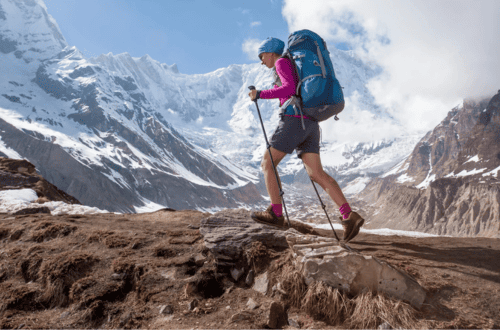Annapurna Circuit Trek Tour: Everything You Need to Know Before You Go
If you're an adventure enthusiast, the Annapurna Circuit Trek Tour is on your radar. Known as one of the most iconic trekking routes in the world, the Annapurna Circuit is a dream destination for hikers. Winding through diverse landscapes, including lush forests, arid deserts, quaint villages, and snow-capped mountains, this trek offers a once-in-a-lifetime experience. But before you pack your bags and lace up your boots, there are a few key things you should know to make your Annapurna Circuit Trek Tour a smooth and unforgettable adventure.
What is the Annapurna Circuit Trek?
The Annapurna Circuit Trek is a 160 to 230 km route that circles the massive Annapurna Massif, taking trekkers through diverse terrains and elevations. The trail traverses the stunning Annapurna Conservation Area, offering breathtaking views of peaks like Annapurna I (8,091 m), Dhaulagiri (8,167 m), and Machapuchare (6,993 m). Along the way, you'll pass through villages, terraced farms, and ancient monasteries, immersing yourself in the unique cultural and natural beauty of Nepal.
The trek typically takes between 12 to 21 days, depending on your pace, the specific route you take, and side excursions.
Best Time to Visit
The best times for the Annapurna Circuit Trek Tour are during the spring (March to May) and autumn (September to November). During these months, the weather is relatively stable, with clear skies and pleasant temperatures, ideal for trekking. The monsoon season (June to August) brings heavy rains, making the trails slippery and dangerous, while winter (December to February) poses extreme cold and the risk of snow-blocked paths, especially at higher altitudes like the Thorong La Pass.

Spring Season (March to May)
In spring, the trails burst with life as rhododendron forests bloom, creating a colorful backdrop for your trek. Temperatures are mild, making the days comfortable for walking, though it can still get chilly at night, especially at higher elevations.
Autumn Season (September to November)
Autumn offers the clearest skies and the most reliable weather for trekkers. The crisp air and bright sunshine highlight the region's towering peaks, making this a favorite season for many hikers.
Required Permits
Before you embark on the Annapurna Circuit Trek Tour, you'll need to secure two permits:
- TIMS (Trekkers' Information Management System) Card: This is required for your safety and to help authorities keep track of trekkers. There are two types of TIMS cards—green (for independent trekkers) and blue (for group trekkers).
- Annapurna Conservation Area Permit (ACAP): This permit is mandatory for entering the Annapurna Conservation Area, where most of the trek takes place. Both permits can be obtained in Kathmandu or Pokhara from the Nepal Tourism Board offices. Ensure you have these documents before starting your trek.
Equipment
- Sleeping Bag:While tea houses offer basic accommodation, having a good-quality sleeping bag rated for cold temperatures will keep you warm and comfortable.
- Trekking Poles: These help reduce strain on your knees and provide stability, especially on steep descents.
- Headlamp: There may be power outages, so a reliable headlamp is handy for night-time activities.
Miscellaneous
- Water Purification Tablets: Access to clean drinking water can be limited, so carry purification tablets or a filtration system.
- Snacks: Energy bars, nuts, and dried fruits will give you the extra boost needed during long trekking days.
- First-Aid Kit: Include blister pads, pain relievers, and altitude sickness medication.
Accommodation and Food
The Annapurna Circuit Trek is known for its "tea house" accommodation. These are small lodges where trekkers can rest, enjoy meals, and socialize with fellow travelers. Although basic, the teahouses are cozy and offer meals like dal bhat (rice and lentils), noodles, momos (dumplings), and Tibetan bread. Prices for food and accommodation rise with altitude due to the cost of transporting goods to more remote locations. It's a good idea to carry some extra cash as ATMs are nonexistent along the trek, and credit cards are rarely accepted.
Altitude Sickness
One of the most significant challenges of the Annapurna Circuit Trek Tour is the risk of altitude sickness, particularly at Thorong La Pass, the highest point of the trek at 5,416 meters. Altitude sickness can cause headaches, dizziness, fatigue, and nausea, which can progress to more severe conditions if not addressed promptly.
Tips for Preventing Altitude Sickness:
- Acclimatize Properly: Build in acclimatization days in Manang and other higher altitude areas.
- Stay Hydrated: Drink plenty of water to keep your body functioning efficiently at high altitudes.
- Ascend Gradually: Follow the "climb high, sleep low" rule, meaning you can climb to higher altitudes during the day but should sleep at a lower altitude to aid acclimatization.
- Recognize Symptoms Early: If you experience symptoms of altitude sickness, descend immediately and seek medical help.
Hiring a Guide or Going Solo?
The Annapurna Circuit Trek Tour can be done either with a guide or independently, depending on your preferences and experience. Hiring a guide or porter is beneficial for several reasons: Local Knowledge: A guide knows the terrain, culture, and weather conditions, ensuring a safer and more enriching experience. Logistics: Porters can carry your heavy gear, allowing you to focus on the trek without the added weight. That said, many trekkers opt to go solo, as the trail is well-marked and well-traveled, especially during peak seasons. However, if you're unfamiliar with high-altitude trekking or want extra support, hiring a guide is a wise choice.
Conclusion
The Annapurna Circuit Trek Tour is a challenging yet rewarding experience that offers adventurers a unique blend of natural beauty and cultural richness. Proper preparation is key to enjoying this adventure to the fullest. From timing your trek right to packing the necessary gear and obtaining the required permits, being well-prepared will ensure a smooth and memorable journey through one of Nepal's most stunning regions.

